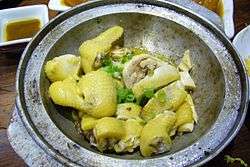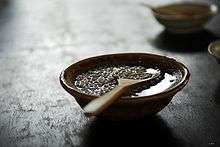Hakka cuisine
Hakka cuisine is the cooking style of the Hakka people, and it may also be found in parts of Taiwan and in countries with significant overseas Hakka communities.[1] There are numerous restaurants in Taiwan, Hong Kong, Indonesia, Malaysia, Singapore and Thailand serving Hakka cuisine. Hakka cuisine was listed in 2014 on the first Hong Kong Inventory of Intangible Cultural Heritage.[2]
| Hakka cuisine | |||||||||||||||
|---|---|---|---|---|---|---|---|---|---|---|---|---|---|---|---|
| Chinese | 客家菜 | ||||||||||||||
| Hakka | Hakka pronunciation: [hak˨ka˩ tsʰoi˥] | ||||||||||||||
| |||||||||||||||
| Alternative Chinese name | |||||||||||||||
| Chinese | 客人菜 | ||||||||||||||
| |||||||||||||||
 |
| Chinese cuisine |
|---|
|
|
Overseas cuisine |
|
Ingredients and types of food |
|
The Hakka people have a marked cuisine and style of Chinese cooking which is little known outside the Hakka home. It concentrates on the texture of food – the hallmark of Hakka cuisine. Whereas preserved meats feature in Hakka delicacy, stewed, braised, roast meats – 'texturised' contributions to the Hakka palate – have a central place in their repertoire. Preserved vegetables (梅菜) are commonly used for steamed and braised dishes such as steamed minced pork with preserved vegetables and braised pork with salted vegetables. In fact, the raw materials for Hakka food are no different from raw materials for any other type of regional Chinese cuisine where what is cooked depends on what is available in the market. Hakka cuisine may be described as outwardly simple but tasty. The skill in Hakka cuisine lies in the ability to cook meat thoroughly without hardening it, and to naturally bring out the proteinous flavour (umami taste) of meat.
The Hakka who settled in the harbour and port areas of Hong Kong placed great emphasis on seafood cuisine. Hakka cuisine in Hong Kong is less dominated by expensive meats; instead, emphasis is placed on an abundance of vegetables. Pragmatic and simple, Hakka cuisine is garnished lightly with sparse or little flavouring. Modern Hakka cooking in Hong Kong favours offal, an example being deep-fried intestines (炸大腸; zhá dà cháng). Others include tofu with preservatives, along with their signature dish, salt baked chicken (鹽焗雞; yán jú jī). Another specialty is the poon choi (盆菜; pén cài).[3] While it may be difficult to prove these were the actual diets of the old Hakka community, it is at present a commonly accepted view. The above dishes and their variations are in fact found and consumed throughout China, including Guangdong Province, and are not particularly unique or confined to the Hakka population.
Besides meat as source of protein, there is a unique vegan dish called lei cha (擂茶; léi chá). It comprises combinations of vegetables and beans. Although not specifically unique for all Hakka people but are definitely famous among the Hakka-Hopo families. This vegetable-based rice tea dish is gaining momentum in some multicultural countries like Malaysia. Cooking of this dish requires the help from other family members to complete all eight combinations. It helps foster the relationship between family members in return.
Steamed bun (茶果) is a popular snack for Hakka people. It is mainly made from glutinous rice and is available in sweet or salty options. Sweet version consists of sweetened black-eyed pea pastes or peanuts. Salty version consists of preserved radish.
Notable dishes
Hakka food also includes other traditional Taiwanese dishes, just as other Taiwanese ethnic groups do. Some of the more notable dishes in Hakka cuisine are listed as follow:
| English | Image | Traditional Chinese | Simplified Chinese | Pinyin | Hakka | Description |
|---|---|---|---|---|---|---|
| Abacus beads | 算盤子 | 算盘子 | suànpánzǐ | [sɔn˥˧ pʰan˩ tsai˧˩] | Made of dough formed from tapioca and yam, cut into abacus-bead shapes, which when cooked, are soft on the outside and chewy on the inside. The dish may be cooked with minced chicken or pork, dried shrimps, mushrooms and various other vegetables. The dish is stir-fried, seasoned with light soy sauce, salt, sugar and sometimes rice wine or vinegar. | |
| Beef meatball soup | 牛肉丸湯 | 牛肉丸汤 | níuròuwán tāng | A simple, clear broth with lettuce and beef meatballs. | ||
| Dongjiang salt-baked chicken |  | 東江鹽焗雞 | 东江盐焗鸡 | dōngjiāng yánjú jī | [tuŋ˦ kɔŋ˦ jam˩ kuk˥ kai˦] | This dish was originally baked in a heap of hot salt, but many modern restaurants simply cook in brine, or cover it with a salty mixture before steaming it or baking it in an oven. The "Dongjiang" refers to the Dong River, which runs through eastern Guangdong Province. It is in the Hakka heartlands. |
| Duck stuffed with glutinous rice | 糯米鴨 | 糯米鸭 | nuòmǐ yā | [nɔ˥˧ mi˧˩ ap˩] | The bones are removed from a whole duck with the shape of the bird maintained, and the cavities filled with seasoned sticky rice. | |
| Fried pork with fermented tofu | This is a popular Lunar New Year offering which involves two stages of preparation. Marinated pork is deep fried to remove moisture so as to preserve it. The pork is then stewed with water and wood's ear fungus. It is a Hakka equivalent to canned soup. | |||||
| Kiu nyuk |  | 扣肉 | 扣肉 | kòu ròu | [kʰju˥˧ ɲjuk˩] | There are two versions of kiu nyuk, the most common consists of sliced pork with preserved mustard greens: thick slices of pork belly, with a layer of preserved mustard greens between each slice, are cooked and served in a dark sauce made up of soy sauce and sugar. The other version is cooked with yam or taro. Usually pork belly is used, for its layers of fat and meat. The yam and pork are shallow fried until browned before being steamed with five-spice powder and yellow rice wine. A variation of the recipe on Wikibooks Cookbook is available here. |
| Lei cha |  | 擂茶 | 擂茶 | lèi chá | [lui˩ tsʰa˩] | An assortment of tea leaves (usually green tea), peanuts, mint leaves, sesame seeds, mung beans and other herbs) are pounded or ground into a fine powder and then mixed as a drink, or as a dietary brew to be taken with rice and other vegetarian side dishes such as greens, tofu and pickled radish. |
| Ngiong tew foo |  | 釀豆腐 | 酿豆腐 | niàng dòufǔ | [ɲjɔŋ˥ tʰɛu˥ fu˥˧] | One of the more popular dishes with deep Hakka origins, it consists of tofu cubes heaped with minced meat (usually pork), salted fish and herbs, and then fried until it produces a golden brown colour, or it can be braised. Variations include usage of various oddments, including eggplants, shiitake mushrooms, and bitter melon stuffed with the same meat paste. Traditionally, ngiong tew foo is served in a clear yellow bean stew along with the bitter melon and shiitake variants. Modern variations that are more commonly seen sold in food stalls are made by stuffing the tofu with solely fish paste. Usage of oddments to replace the tofu are more noticeable in this version, ranging from fried fish maw slices and okra to chili peppers. |
| Steamed sticky rice pastry | 粢粑 | 粢粑 | qĭ bá | |||
Hakka cuisine in South Asia
In India, Pakistan and other regions with significant South Asian populations, the locally known "Hakka cuisine" is actually a Desi adaptation of original Hakka dishes. This variation of Hakka cuisine is in reality, mostly Indian Chinese cuisine and Pakistani Chinese cuisine. It is called "Hakka cuisine" because, in India and areas of Pakistan, many owners of restaurants who serve this cuisine are of Hakka origin. Typical dishes include 'chilli chicken' and 'Dongbei (northeastern) chow mein/hakka noodles' (an Indian version of real Northeastern Chinese cuisine), and these restaurants also serve traditional South Asian dishes such as pakora. Being very popular in these areas, this style of cuisine is often mistakenly credited as being representative of Hakka cuisine in general, whereas the authentic style of Hakka cuisine is rarely known in these regions.
Outside of South Asia, the premier place to enjoy Indo-Pak-Chinese cuisine is in Toronto, Canada, due to the large number of Chinese from South Asia who have emigrated to the region and have chosen to open restaurants and most of it being halal.
Hakka cuisine in Thailand
In Thailand, Bangkok's Chinatown is Yaowarat and including neighboring areas such as Sampheng, Charoen Chai, Charoen Krung, Suan Mali, Phlapphla Chai or Wong Wian Yi Sip Song Karakadakhom (July 22 Circle). In the past, many Hakka restaurants are located in the Suan Mali near Bangkok Metropolitan Administration General Hospital. But now they had moved into many places, such as Talad Phlu, which is also one of the Chinatown as well.[4]
See also
References
- Lau Anusasananan, Linda (2012). The Hakka Cookbook: Chinese Soul Food from Around the World. Berkeley and Los Angeles: University of California Press. ISBN 0520273281.
- Item 5.27, "First Hong Kong Inventory of Intangible Cultural Heritage" (PDF). Intangible Cultural Heritage Advisory Committee, Leisure and Cultural Services Department, Hong Kong. 17 June 2014. Retrieved 24 November 2014.
- Sterling, Richard; Chong, Elizabeth; Qin, Charles Lushan (2001). World Food Hong Kong. Hong Kong: Lonely Planet Publishing. ISBN 1-86450-288-6.
- แม่ช้อยนางรำ (2013-06-14). ""เอี้ยวฮิน" ร้านอาหารแคะ เจ้าสุดท้าย?". Manager Daily (in Thai).